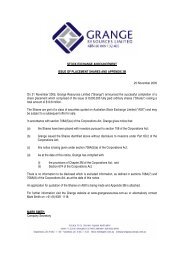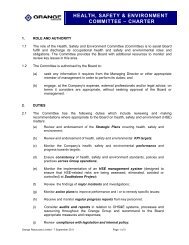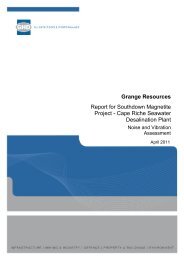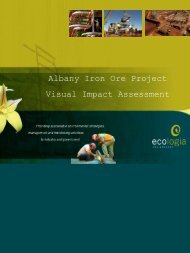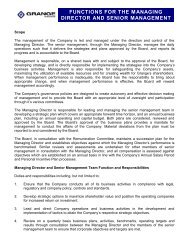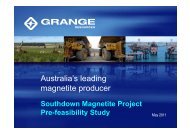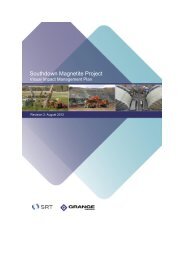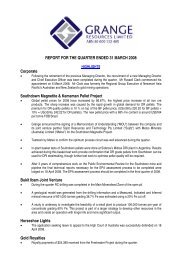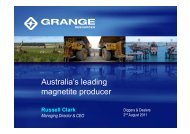Appendix A - Flora and Fauna Survey - Grange Resources
Appendix A - Flora and Fauna Survey - Grange Resources
Appendix A - Flora and Fauna Survey - Grange Resources
You also want an ePaper? Increase the reach of your titles
YUMPU automatically turns print PDFs into web optimized ePapers that Google loves.
community – Swamp Yate (Eucalyptus occidentalis) woodl<strong>and</strong>s in seasonally inundated clay basins<br />
(South Coast) is within the Project footprint. This includes:<br />
� 0.66 ha on the corner of Mettler Lake Road <strong>and</strong> Cape Rich Road; <strong>and</strong><br />
� 0.27 ha along South Coast Highway.<br />
Ecologia (2008a) assessed the extent of the Swamp Yate (Eucalyptus occidentalis) woodl<strong>and</strong>s in<br />
seasonally inundated clay basins (South Coast) within the East S<strong>and</strong> Plain Sub-catchment, <strong>and</strong> identified<br />
the presence of 44 ha of this community in Good to Excellent condition. Ecologia (2008a) also state that<br />
the total area of this vegetation is likely to be significantly higher if the areas were mapped in detail.<br />
Taking a conservative approach (using the 44 ha sub-catchment extent), the 0.93 ha of the Swamp Yate<br />
PEC to be cleared for this Project is estimated to be approximately 2% of that present in the subcatchment.<br />
The habitat types to be cleared are represented within <strong>Grange</strong>’s proposed offset site, including areas<br />
mapped by the DEC <strong>and</strong> verified during the offset investigations (GHD, 2011) as the Swamp Yate PEC.<br />
The offset package includes sufficient offsets for the mine site, plus additional areas for clearing<br />
associated with this Project.<br />
Given the small extent of native vegetation to be cleared, <strong>and</strong> the provision of an offset site, the clearing<br />
is not expected to result in a significant impact to biodiversity locally or regionally.<br />
Four Priority species were identified during the field survey. These were recorded in low densities in a<br />
small number of quadrat sites. The Lasiopetalum aff monticola specimen was collected near quadrat 9<br />
within road reserve along Cape Riche Road.<br />
The four Priority species are present across a range of areas along the south coast <strong>and</strong> all are<br />
represented by a number of records in the Western Australian herbarium. The Table 3 below provides<br />
an indication of their known range.<br />
Table 3 Priority Species Recorded within the Project Area <strong>and</strong> their Range<br />
Priority<br />
Species<br />
No. of Herbarium<br />
Records (plants*)<br />
General Range<br />
Monotoca aristata (P2) 19 (220+)* Common locally. Mt Maxwell.<br />
Chordiflex<br />
leucoblepharus (P2)<br />
19 (unknown). A<br />
number of records state<br />
it as ‘common’ or ‘very<br />
common’.<br />
Goodenia filiformis (P3) 19 (unknown). A<br />
number of records state<br />
it as ‘common’.<br />
Kunzea pauciflora (P4) 20 (2170+). Records<br />
state it as ‘abundant’.<br />
Cranbrook, Stirling Range, to Wellstead. Many in protected<br />
reserves.<br />
Cowaramup (near Margaret River) to Wellstead<br />
Common in Cape Riche area, much of which is protected in<br />
reserves.<br />
* Plant numbers in herbarium records are often not stated. Where they are not stated only one plant has been counted,<br />
which could considerably underrepresent the number of plants present. In addition, a number of records state that the<br />
plant is ‘common’ or ‘scattered’. These have also only been counted as one.<br />
Given the limited extent of vegetation clearing associated with the Project <strong>and</strong> presence of similar habitat<br />
surrounding the alignment (including within the offset site) clearing for the Project is not expected to<br />
result in significant losses to priority species.<br />
24



